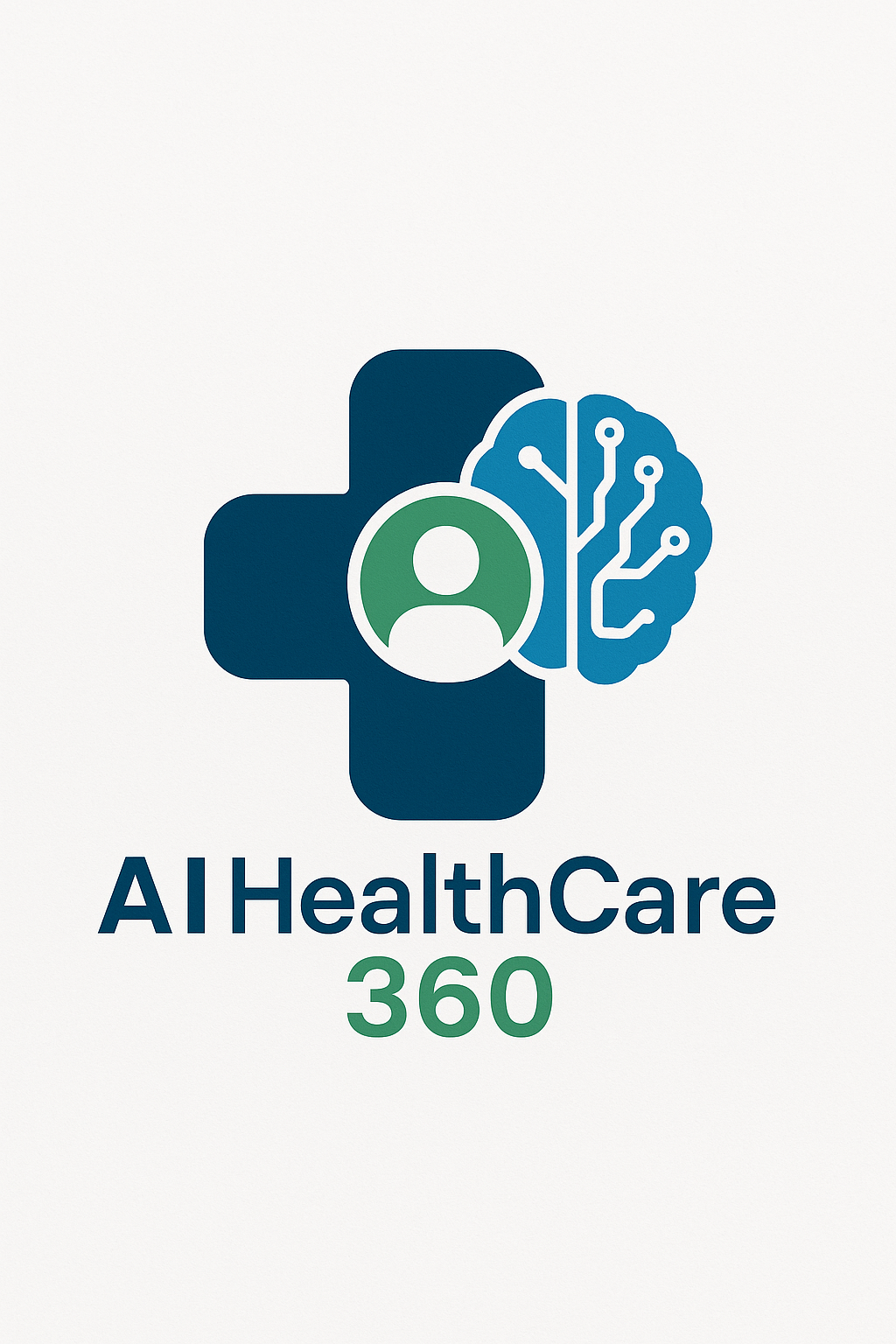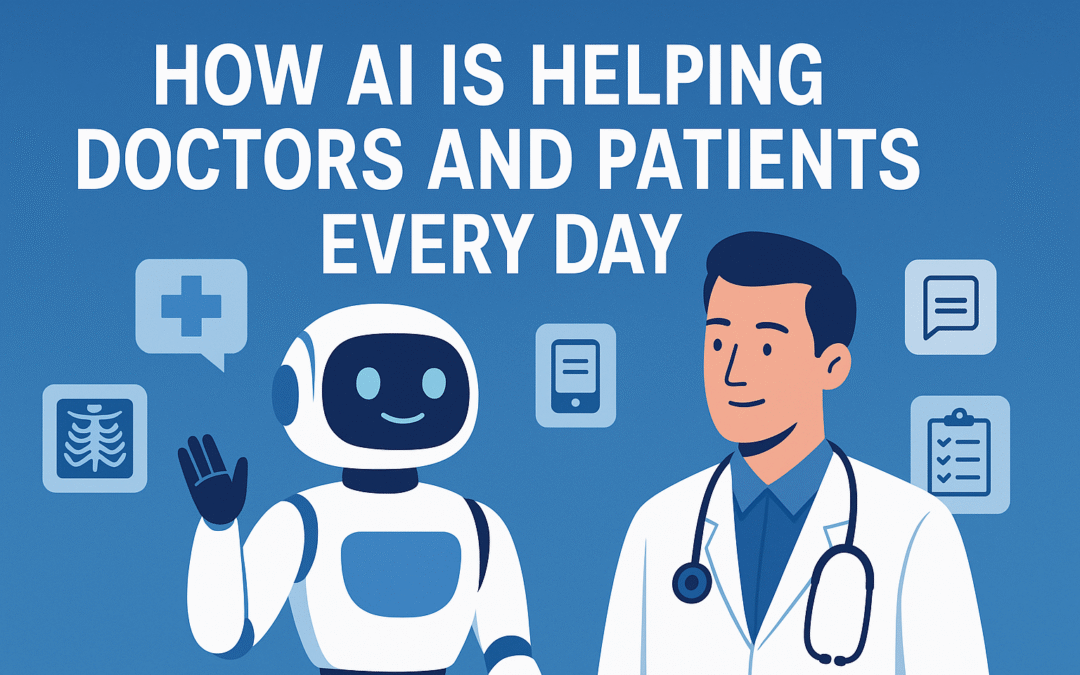Introduction
AI in healthcare is no longer just for research labs. In everyday care — regular clinic visits, follow-ups, messages, refills, and managing long-term conditions — AI in Healthcare is helping answer questions faster, reduce paperwork, and spot issues earlier so people get help sooner. For doctors, it reduces time at the keyboard; for patients, it shortens waits and improves access to advice day and night. This article explains where AI is already working, with real-world examples and clear guidance on how to use it safely.
Here are some quick real-world proofs of AI already making a difference in hospitals and clinics:
Fast Facts: Real-World AI in Healthcare Examples
-
Stroke triage: FDA permitted marketing of Viz.ai to analyze CTs and alert specialists—first of its kind in 2018; now used in over 1,600 hospitals.
-
Post-visit check-ins: UPenn “Penny” texts oral-chemo patients daily to catch problems early. (AAMC)
-
24/7 access: Cedars-Sinai Connect (with K Health) handled 42k+ patients in year one; AI drafts recommendations that MDs confirm.(Business Insider)
-
Documentation relief: Permanente physicians saved ~15,791 hours in a year using AI scribes.(AMA)
-
Operational flow: Qventus and LeanTaaS help hospitals cut delays and boost OR scheduling — Banner Health reported double-digit ROI with Qventus.(Hit Consultant)
What types of AI are already helping doctors & patients today
1) Clinical decision support & diagnostics (imaging/triage)
What it does, in simple terms: AI reviews scans (like CT) and flags urgent problems so specialists are alerted quickly.
US example: An example is Viz.ai — the FDA permitted marketing of its stroke triage software that reviews CT scans and alerts stroke teams. It’s now widely deployed in hospitals across the country and internationally.
Why it matters: For stroke, minutes matter. Faster specialist alerts can reduce disability by getting patients to treatment sooner.
2) Communication & follow-ups (texts/chatbots)
What it does: After you leave the clinic, AI tools check in by text or chat—reminders, side-effect checks, simple guidance, and flags to the care team when something looks risky.
UPenn “Penny”
At the University of Pennsylvania’s Abramson Cancer Center, the ‘Penny’ system sends two-way texts to oral-chemotherapy patients each day (checking if meds are taken and tracking symptoms). It alerts clinicians when follow-up is needed, improving safety and adherence.
Cedars-Sinai Connect
Cedars-Sinai Connect in Los Angeles, powered by K Health, offers 24/7 virtual care with AI-driven symptom assessment and intake. More than 42,000 patients used it in its first year, helping doctors focus on treatment.
3) AI scribes (documentation)
What it does: Listens during the visit, then drafts the note so physicians can face the patient, not the screen.
- The Permanente Medical Group (Northern California): ~15,791 hours saved in one year across 2.5M encounters, with improved physician–patient interaction (AMA coverage; NEJM Catalyst summary by Permanente).
-
Cleveland Clinic: Announced rollout of Ambience Healthcare’s AI documentation platform after multi-specialty pilots.
4) AI intake & patient access tools (registration, forms, eligibility, payments)
What it does: Speeds up check-in, pre-visit forms, insurance capture, and screening so visits start on time and front desks aren’t overwhelmed.
For Example, Phreesia (widely used across the US): reports ~170 million patient visits enabled in 2024 (about 1 in 7 US visits), indicating scale and common use of digital intake and patient access workflows.
5) Remote/home monitoring (chronic care)
What it does: Devices and apps collect vitals/symptoms at home; AI flags trends so teams can intervene earlier and avoid emergency visits.
For example, Systems like Mayo Clinic and Hackensack Meridian Health are working with Google Cloud to build generative-AI search/chat across clinical data, a building block that supports better virtual and remote workflows.
Benefits of AI in Healthcare
-
Faster care: Imaging AI and virtual intake speed up triage and appointments; for time-sensitive events like stroke, earlier alerts matter.
-
More face time: AI scribes cut typing time, so clinicians look at patients, not screens.
-
Fewer dropped balls after visits: Texting/chat tools catch issues earlier and remind patients about meds and tests.
-
Smoother days: Intake tools and ops AI reduce bottlenecks and no-show waste, improving flow and access.
Risks & what to watch
-
Accuracy varies by setting: AI that performs well in one hospital might stumble elsewhere (data, workflow, equipment). Keep human review in the loop.
-
Bias/fairness: Some algorithms have shown racial bias—leaders must validate local performance and equity. (Seminal US example in Science.)(PubMed)
-
Privacy: Consumer chatbots are not automatically HIPAA-covered; use health-system tools and portals for personal data. (General cautionary reporting.)(VeryWell Health)
-
Change management: Integrations, training, and ongoing monitoring are required for safe adoption (most large systems report phased rollouts).
How patients can get the most benefit
-
Use your health system’s official tools (portal, Connect-type apps) for privacy and continuity with your care team.
-
Answer follow-up texts honestly (meds, symptoms); these messages are designed to catch problems early.
-
Treat AI answers as assistance, not medical orders—confirm important advice with your clinician.
-
If a tool seems wrong or confusing, message your care team through the portal.
How clinicians & admins can get the most benefit
-
Start where evidence is strongest: imaging triage (e.g., stroke), AI scribes, digital intake, and targeted follow-up texting.
-
Pick vendors with peer-reviewed or multi-site results and clear HIPAA/security posture.
-
Pilot in a few clinics/specialties, measure note time saved, message turnaround time, throughput, and patient satisfaction; then scale. (Cleveland Clinic’s phased approach is a good model.)
-
Maintain human-in-the-loop review and set up quality dashboards for ongoing model performance and bias checks.
-
Communicate clearly with patients about how AI is used in your clinic.
FAQs AI in Healthcare
1. How does AI help doctors in everyday care?
AI reduces paperwork through scribes, speeds up imaging triage, and assists with intake and scheduling. Doctors get more face-to-face time with patients instead of screens.
2. How does AI help patients day-to-day?
Patients benefit from reminders, symptom check-ins, faster access to advice, and fewer delays at appointments. Tools like Cedars-Sinai Connect and UPenn’s “Penny” system show how AI helps patients feel supported between visits.
3. Is AI safe to rely on for daily medical questions?
AI provides quick guidance but is not a substitute for a doctor. Most systems are designed with oversight — clinicians confirm important decisions before treatment.
4. Will AI replace the human touch in care?
No. AI is meant to handle routine tasks like notes and reminders so doctors can focus more on listening and treating. The human relationship stays central.
5. What are the risks of using AI in daily healthcare?
Key risks include errors if unchecked, data privacy concerns, and possible bias. That’s why hospitals use AI as an assistant with human review, not as a replacement.
Conclusion
AI in healthcare is already improving everyday care in the US: faster triage for emergencies, better communication after visits, fewer administrative headaches, and more face time between clinicians and patients. The best results happen when organizations roll out evidence-based tools (imaging triage, AI scribes, intake, texting) with human oversight, privacy by design, and clear measurement of outcomes.

